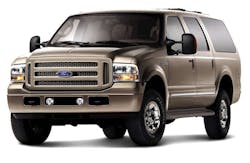I had spent the year prior to my 16th birthday working at my father’s tire shop unloading and stocking tires in between janitorial duties and whitewall scrubbing. So before I could legally drive a car, I thought I understood the differences between passenger and light truck tires.
The first thing I noticed was the “LT” molded on the sidewall, which dictated to me where they needed to be inventoried. They also were a lot heavier, which stunk because the light truck tire storage area was up a narrow flight of stairs to a second floor mezzanine.
At the time, some of them had 16.5-inch bead diameters, which were easy to spot because the bead was at a sharper angle as opposed to the “square” beads of passenger tires. Radial light truck tires also were easy to identify because the letter “R” would be molded on the sidewall, and they were even heavier yet. Other than that, they seemed to be just like passenger tires only a little bigger.
I know better today. But not everybody does.
To the uninitiated, that’s understandable. It doesn’t appear that there is much of a difference between a pickup truck or sport utility vehicle (SUV) that uses passenger tires and one that uses light truck tires. Also, the service procedures for passenger and light truck tires are performed on the same equipment and, for the most part, they are similar in nature.
The most significant difference for consumers is probably the price — and that’s where the trouble starts.
Les Cook, manager of tire application engineering for Cooper Tire & Rubber Co., spends a lot of his time dealing with consumer problems in the field. He says they ultimately end up as a training seminar for the dealer who sold the tire.
“With light truck tires, I’m seeing a lot of misapplication that’s being promoted by dealers, and whether they realize they’re doing it or not, it’s a problem for the industry and it needs to be straightened out.”
In most of these cases, the customer drives a large SUV or pickup truck that requires a light truck tire with a higher load-carrying capacity than a passenger tire of the same size. The dealer thinks he’s doing the customer a favor by selling him a less expensive, P-metric tire.
“I recently had a complaint on 3/4-ton van that required Load Range E tires, but the dealer installed a set of P-metric passenger tires with a load index that was much lower. The van was used to pull a boat, and within the first 90 miles, cracks started forming on the sidewall.
“Fortunately, we were able to get the passenger tires off the van and replace them with a set of light truck tires that conformed to the placard before they failed in service,” says Cook. “If the dealer had followed the information on the placard to begin with, the whole problem could have been avoided.”
[PAGEBREAK]
Confusion with the Ford Excursion
Cook says he sees P-metric vs. LT tire problems on Ford Excursions quite often. Here’s the scenario.
1. The original equipment tire size on the Excursion is an LT265/75R16 Load Range E with a load index of 123. That translates to a maximum load-carrying capacity of 3,472 pounds.
2. If an LT265/75R16 Load Range D tire with a load index of 119 is used as a replacement tire, then the maximum load for each tire will be reduced to 3,074 pounds.
3. If the P265/75R16 with a load index of 114 is used, the maximum load is reduced to 2,640 pounds.
4. If the LT265/75R16 Load Range C with a load index of 112 is used, the maximum load is reduced even further to 2,484 pounds.
To the outside observer, the P-metric tire carries more load than the light truck tire with a Load Range C. This may be true as long as the tires are carrying the load for a limited amount of time.
However, LT tires are engineered to operate at maximum load for an indefinite amount of time. In fact, every component of a light truck tire is designed with an extra safety factor to accommodate the increased stress that comes with higher loads and inflation pressures.
According to Cook, the steel belts are heavier, and there are typically stronger radial cords with more cords per inch on a light truck tire when compared to a passenger tire. Finally, the difference in physical weight is often more than 10 pounds between the two, which further illustrates the heavy-duty nature of light truck tires when compared to passenger tires.
In other words, passenger tires are not designed or engineered to operate at the maximum limits.
So even though the P265/75R16 can technically carry more weight than the light truck tire with the lower load index, it is unlikely to operate at maximum capacity for very long.
If the vehicle placard on a pickup truck or SUV calls for Load Range E light truck tires, then the best practice is to use the same Load Range and load index when replacing them. Downgrading to a passenger tire may save a few dollars and give the customer a softer ride, but it creates serious risks if the vehicle is ever loaded to capacity for an extended period of time
In the example that Cook describes, it only took 90 miles for new tires to start developing sidewall cracks that would have led to failure.
[PAGEBREAK]
Replacing dual rear tires
Cook says he also has handled more than one situation where a vehicle had dual rear tires and the retailer substituted passenger tires because the customer wanted to save a few dollars and didn’t say anything about hauling a boat or camper.
One of the reasons maximum dual loads are less than maximum single loads is that in a dual application, there is increased heat due to the close proximity of the sidewalls. All dual tires have a minimum dual spacing that takes this proximity into account and establishes the distance from the centerline of the inner rim to the centerline of the outer rim.
Light truck tires are designed with this in mind, which explains the inflation pressures and maximum loads for dual and single applications molded on the sidewall.
Passenger tires, both P-metric and Euro-metric, do not have dual inflation pressures or maximum loads molded on the sidewalls because they are not engineered to operate in dual positions.
When the problem is compounded by Plus-sizing, P-metric and Euro-metric replacement tires can result in very little, if any, space between the duals.
That’s why owners of pickup trucks are one of the biggest offenders when it comes to downgrading replacement tires. A lot of these vehicles are used for day-to-day transportation, so drivers are reluctant to spend the extra money on light truck tires with Load Range E capacity and inflate them to the pressure on the placard when they “never haul anything.”
When they do haul something with passenger tires, however, the potential for failure comes into play. The same can be said for downgrading from Load Range E to Load Range D.
Pickup truck owners are rolling the dice because the potential to haul a heavy load is always there, and if the wrong tires are ever asked to operate for an extended period of time at maximum load for the vehicle, they may not hold up.
And if they don’t, the plaintiff’s attorney will have all the evidence necessary at the scene of the accident.
Recently released tire replacement guidelines from the Rubber Manufacturers Association specifically state that, “Unless otherwise specified by the vehicle manufacturer, it is not recommended to replace OE LT-metric, High-Flotation/Wide Base or Numeric tires with P-metric or European-metric tires.”
That recommendation is just another reason to follow the placard when replacing tires on a vehicle that requires light truck tires.
[PAGEBREAK]
The TPMS effect
Now that most pickup trucks include a tire pressure monitoring system (TPMS), reducing the inflation pressure in the rear tires to improve the ride and tire wear usually results in a low tire pressure indicator light on the dashboard.
Before I explain why, note my use of the word “usually.” It’s important to remember the basic principles of a TPMS. First of all, the low tire inflation pressure threshold is 25% of the pressure listed on the vehicle’s tire placard. If the placard calls for 80 psi in the rear tires, then the TPMS light will be triggered as soon as the inflation pressure goes below 60 psi.
The last I heard, light trucks and SUVs manufactured by General Motors Corp. can be reprogrammed with a lower threshold by the dealer, so the TPMS can operate as intended at a lower inflation pressure. Other exceptions are some Dodge pickup trucks that include a “Light Load” switch which allows the driver to reduce the inflation pressure in the tires while resetting the threshold for the TPMS indicator.
What you can do
Rather than get into another “blame it on the lawyers” rant, I want to focus on what tire retailers should do when confronted with consumers who are driving vehicles that require light truck tires.
If the placard calls for a specific size tire with Load Range E, then the best practice is to install replacement tires with the same size and Load Range. If you explain to consumers that this should be done in the interest of safety, then the chances of them selecting the proper tire for the vehicle are much better.
The same goes with inflation pressure. If the vehicle has a TPMS, then the trigger is 25% of the placard, so the best practice is to inflate the tire to the placard pressure. I feel bad about saying this because it doesn’t really “help” the consumer, but the legal ramifications can be severe if the placard is not followed to the letter.
The worst practice is to replace an LT tire with a passenger tire, because the safety factor for operating close to the maximum limits is not there. Light truck tires are especially designed to withstand that type of stress and are built with an extra margin of safety.
Even if the information on the sidewall of the passenger tire indicates that it can carry the load, it is not designed to operate at or near maximum capacity for an extended period of time. And since most drivers fail to check their tire inflation pressure on a monthly basis, the margin for error becomes razor thin.
In tough economic times like this, it’s perfectly human to have sympathy for someone needing expensive light truck tires when they swear that they only drive it back and forth to work and the grocery store.
Retailers must understand that by doing their light truck or SUV customers a favor, they have exposed themselves and their customers to a safety risk that may cost someone a life. ■
[PAGEBREAK]
Light truck tire size trends
Here are five sizes common to both the P-metric/metric light truck and LT light truck tire segments. The percentages are a comparison of first-half 2008 shipments to first-half 2009 shipments.
Size LT/flotation Passenger
265/75R16 down 19.2% up 19.4%
245/75R16 flat down 2.3%
265/70R17 up 26.1% up 1.7%
225/75R16 flat up 31%
235/75R15 down 28.9% down 21.1%
Source: Rubber Manufacturers Association/Kumho Tire U.S.A. Inc.


